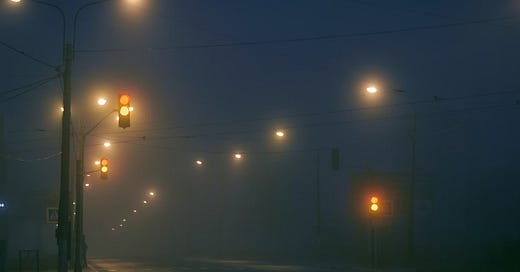Photo by Daniil Onischenko at Unpslash.
The darkness of November is upon us. Dense layers of fog are nibbling at the short days here in Sacramento. Yesterday I learned that the fog has a name. Tule fog, a low cloud formation in California’s Central Valley, near the foothills of the Sierra Nevada, dramatically reduces visibility, not unlike the Delhi winter smog. On Friday I went out to get groceries in the late afternoon and while driving back I could see very little of what lay ahead of me. It felt like the beginning of a horror story.
Sacramento has its fair share of ghosts, and some of the more popular ones call the Sacramento Theater their home. I am particularly intrigued by the spirit of Madame Modjeska, who watches wistfully as actors put on their costumes and make up in the dressing room.
Madame Modjeska is said to be a failed Polish or Hungarian actress. The story is familiar--a woman with unfulfilled desires refuses to rest in peace and instead goes around haunting the living. Given how societal structures have actively thwarted women’s desires for centuries, the ghost in the story is also guilt.
What strikes me as really remarkable in the case of ghost/woman Madame Modjeska though is her name. She shares it with an extremely successful and popular actress who emigrated from Poland to California in the nineteenth century--Helena Modjeska.
In Warsaw, Helena Modjeska played leading roles in Shakespeare’s tragedies. She was Ophelia, Juliet, Desdemona. When she moved to the US--to Anaheim in Southern California--in 1876, she struggled to learn English. Nonetheless, she managed to enter the theater circuit. She acted at the California Theater in San Francisco, debuted in New York, produced Henrik Ibsen’s A Doll’s House, and even spoke about the conditions of Polish women at the Chicago World’s Fair. Susan Sontag’s In America (1999) is supposed to be inspired by Helena Modjeska’s life.
The Madame Modjeska who haunts Sacramento Theater is not Helena Modjeska, cannot be. But I wonder if Helena Modjeska’s success did not play a part in the construction of the legend around a failed actress. The urban ghost story is meant to foil the history of a woman who lived. Perhaps.
In this month’s Outspoken-ish newsletter, P. will look for the place of women and silenced voices in horror. From being a proper fan of the scary movies and shows labeled ‘feminist horror’, P. went to not caring about them, only to be getting some of the keenness back. Why? What are the cultural and historical roots of this so-called ‘feminist horror’?
P.’s letter will be in your inbox soon with a closer look at classics like Halloween and the reboots, desi cult horror made by the Ramsay bros., and more recent experiments like Us and Bulbbul.
Until then, wishing you warmth for the cold days and nights,
T
Photograph of Helena Modjeska acting in As You Like It. Source: https://picryl.com/media/helena-modjeska-1840-1909-1






I knew of this spirit story, thanks for adding some context. I remember studying folk archetypes as a sort of tangental interest in my undergrad major and during my dissertation work. Many are (as I understand it now) patriarchal cautionary tales, if you will. I always value your contributions to my day. Thanks T and P (whom I hope to meet sometime!)